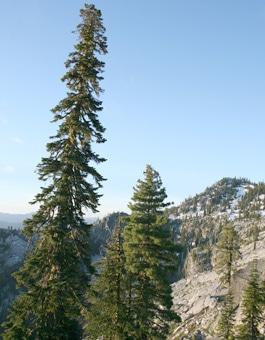

Choice of urban landscapers
The Pacific silver fir is popular among landscapers because its silver leaves and bark and deep purple cones provide a regal combination. It also makes it a sought-after Christmas tree. Its soft, lightweight wood is weak and has low durability, so it has limited use commercially.
Range
Native to the Pacific Northwest, Pacific silver fir ranges from southern Alaska to northern California. Well-developed stands are primarily found at elevations from 1,000 to 7,000 feet on the coastal slopes of the Cascades.
Character
A Mature Pacific silver firs typically reaches 100 to 230 feet in height and up to 45 inches in diameter. It has cylindrical cones, 3.5 to 6 inches long, occupying the tips of the uppermost branches. Most of the needle-like leaves are 0.5 to 1.3 inches long, are are bright green and somewhat flattened, and have notched tips.
Understory
The understory of the Pacific silver fir will vary depending on moisture availability. Understory shrubs include the Vine maple, Salal, Cascade Oregon grape, Blueberry and Mountain Huckleberry. The dense growth of Pacific silver fir provides cover and protection during the winter for wildlife.
Climate
Pacific silver fir occurs most often in areas with high precipitation and moist soils, like the mid-slope of the western Cascades. It thrives in maritime climates with high annual precipitation and average summer temperatures around 59°F.
Management
Pacific silver fir is dependent on adequate soil moisture during the growing season. It is most abundant on sites where summer drought is minimal, such as areas of heavy rainfall, seepage or prolonged snowmelt.